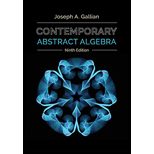
Which of the following binary operations are closed?
a. subtraction of positive integers
b. division of nonzero integers
c. function composition of polynomials with real coefficients
d. multiplication of
e. exponentiation of integers
a.
Whether the given set is closed or not.
Answer to Problem 1E
The given set of positive integers is not closed under subtraction operation.
Explanation of Solution
Given:
Set of positive integers and operation is subtraction.
Concept Used:
An set G is said to be closed under operation
Calculation:
Given setof positive integers is not closedunder the operation subtraction as because there exist some elements
The result,
Hence the given set of positive integers is not closed under subtraction operation.
Conclusion:
The given setof positive integers is not closed under subtraction operation.
b.
Whether the given set is closed or not.
Answer to Problem 1E
The set of non zero integers is not closed under division operation.
Explanation of Solution
Given:
Set is non zero integers and operation is division
Concept Used:
An set G is said to be closed under operation
Calculation:
Given set non zero of integers is not closed under the operation division as because there exist some elements
The result
Hence the given set of non zero integers is not closed under division operation.
Conclusion:
The the given set of non zero integers is not closed under division operation
c.
Whether the given set is closed or not.
Answer to Problem 1E
The given set of polynomial functions with real coefficients is closed under composion.
Explanation of Solution
Given:
Set of polynomial functions with real coefficients and operation is composition.
Concept Used:
An set G is said to be closed under operation
Calculation:
Given set is closed under the operation composition
Thus
Hence the Set of polynomial functions with real coefficients is closed under the operation composition.
Conclusion:
The given the Set of polynomial functions with real coefficients is closed under the operation composition.
d.
Whether the given set is closed or not.
Answer to Problem 1E
The given set of matrix of order
Explanation of Solution
Given:
Set of matrix of order
Concept Used:
An set G is said to be closed under operation
Calculation:
Given set of matrix of order
Thus
Hence the given set of matrix of order
Conclusion:
The given set of matrix of order
e.
Whether the given set is closed or not.
Answer to Problem 1E
The given set of integers is not closed under exponent operation.
Explanation of Solution
Given:
Set of integers and operation is exponent.
Concept Used:
An set G is said to be closed under operation
Calculation:
Given set of integers is not closed under the exponent as because there exist some elements
The result,
Hence the given set of integers is not closed under exponent operation.
Conclusion:
The given set of integers is not closed under exponent operation.
Want to see more full solutions like this?
Chapter 2 Solutions
Contemporary Abstract Algebra
- Evaluate the following expression and show your work to support your calculations. a). 6! b). 4! 3!0! 7! c). 5!2! d). 5!2! e). n! (n - 1)!arrow_forwardAmy and Samiha have a hat that contains two playing cards, one ace and one king. They are playing a game where they randomly pick a card out of the hat four times, with replacement. Amy thinks that the probability of getting exactly two aces in four picks is equal to the probability of not getting exactly two aces in four picks. Samiha disagrees. She thinks that the probability of not getting exactly two aces is greater. The sample space of possible outcomes is listed below. A represents an ace, and K represents a king. Who is correct?arrow_forwardConsider the exponential function f(x) = 12x. Complete the sentences about the key features of the graph. The domain is all real numbers. The range is y> 0. The equation of the asymptote is y = 0 The y-intercept is 1arrow_forward
- The graph shows Alex's distance from home after biking for x hours. What is the average rate of change from -1 to 1 for the function? 4-2 о A. -2 О B. 2 О C. 1 O D. -1 ty 6 4 2 2 0 X 2 4arrow_forwardWrite 7. √49 using rational exponents. ○ A. 57 47 B. 7 O C. 47 ○ D. 74arrow_forwardCan you check If my short explantions make sense because I want to make sure that I describe this part accuratelyarrow_forward
- 9! is 362, 880. What is 10!?arrow_forwardBruce and Krista are going to buy a new furniture set for their living room. They want to buy a couch, a coffee table, and a recliner. They have narrowed it down so that they are choosing between \[4\] couches, \[5\] coffee tables, and \[9\] recliners. How many different furniture combinations are possible?arrow_forwardCan you check if my step is correct?arrow_forward
 Algebra: Structure And Method, Book 1AlgebraISBN:9780395977224Author:Richard G. Brown, Mary P. Dolciani, Robert H. Sorgenfrey, William L. ColePublisher:McDougal Littell
Algebra: Structure And Method, Book 1AlgebraISBN:9780395977224Author:Richard G. Brown, Mary P. Dolciani, Robert H. Sorgenfrey, William L. ColePublisher:McDougal Littell
 College Algebra (MindTap Course List)AlgebraISBN:9781305652231Author:R. David Gustafson, Jeff HughesPublisher:Cengage Learning
College Algebra (MindTap Course List)AlgebraISBN:9781305652231Author:R. David Gustafson, Jeff HughesPublisher:Cengage Learning Glencoe Algebra 1, Student Edition, 9780079039897...AlgebraISBN:9780079039897Author:CarterPublisher:McGraw HillAlgebra & Trigonometry with Analytic GeometryAlgebraISBN:9781133382119Author:SwokowskiPublisher:Cengage
Glencoe Algebra 1, Student Edition, 9780079039897...AlgebraISBN:9780079039897Author:CarterPublisher:McGraw HillAlgebra & Trigonometry with Analytic GeometryAlgebraISBN:9781133382119Author:SwokowskiPublisher:Cengage Trigonometry (MindTap Course List)TrigonometryISBN:9781337278461Author:Ron LarsonPublisher:Cengage Learning
Trigonometry (MindTap Course List)TrigonometryISBN:9781337278461Author:Ron LarsonPublisher:Cengage Learning





